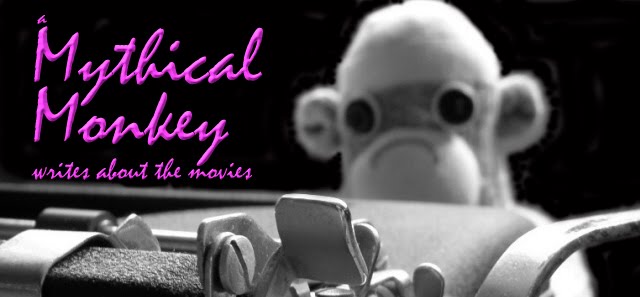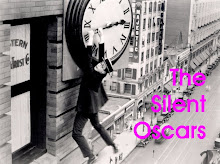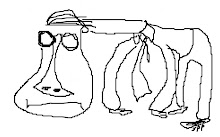 I've written about D.W. Griffith quite a bit—most wordily here, here, here and here.
I've written about D.W. Griffith quite a bit—most wordily here, here, here and here.Like every other director of that era, Griffith wrestled with the problem of narrative—how to tell a story in a silent medium—but whereas other directors simply parroted the techniques that worked on stage and wound up with actors in togas milling around in front of painted backdrops, Griffith seemed to understand from the outset that film presented its own unique set of problems and opportunities. By composing his actors within the frame, by relying on revealing actions rather than words and, especially, by juxtaposing images and events through editing, Griffith was able to create within his audience an emotional involvement in his stories.
A trio of short films from 1909 illustrate Griffith's gift at composing the frame, staging action, and creating suspense with pacing and editing.
One of five Griffith films preserved in the National Film Registry, A Corner In Wheat is overpraised (to my mind) for being the first "message picture," but its use of composition is masterful. Lone figures confined to the corner of the screen, overwhelmed by empty vistas, conveying through image alone the desperation the characters feel, could have come straight from an Edward Hopper painting—except that A Corner In Wheat pre-dates Hopper's style by some fifteen years.

 The Country Doctor opens with a panning shot, which if you'd just watched 100+ movies from the years that preceded it, believe me, jumps off the screen with its technical sophistication. Starting with a long shot of a valley, then panning to a house on a hill to focus on a family already emerging to walk forward until they stand in medium shot, Griffith establishes with a single uninterrupted camera movement both the story's setting and the identity and socio-economic status of its characters, the sort of camera shot we take for granted now but which pretty much didn't exist before him.
The Country Doctor opens with a panning shot, which if you'd just watched 100+ movies from the years that preceded it, believe me, jumps off the screen with its technical sophistication. Starting with a long shot of a valley, then panning to a house on a hill to focus on a family already emerging to walk forward until they stand in medium shot, Griffith establishes with a single uninterrupted camera movement both the story's setting and the identity and socio-economic status of its characters, the sort of camera shot we take for granted now but which pretty much didn't exist before him.That only a year into his career as a director, he concluded the tragic story with a mirror of that opening shot, panning from the now-empty house as the film ends to that same long shot of the valley, underscores just how quickly he raced ahead of his competitors in using film to convey emotion.
Griffith didn't invent intercutting (a.k.a. cross-cutting)—the use of editing to alternate between two locations, usually to show simultaneous action—but he took it farther than anyone before him, using it not just to, say, show a key prop or establish a location, but to create a narrative flow and a sense of anticipation that was sorely lacking in early movies. In the thriller The Lonely Villa thieves break into a secluded country home and terrorize a woman and her children while her husband and the police race to their rescue. Griffith cuts back and forth between three points of view to create genuine suspense—will the would-be rescuers arrive in time to save the day?—an editing technique still used to this day.
Griffith continued to develop new approaches to film storytelling throughout his career at Biograph—parallel storylines, follow focus, the iris shot—culminating in what is now know as "classical Hollywood continuity," the practice of cutting within a scene to make clear to the viewer at all times where the characters are in relationship to each other and to their surroundings, both in terms of the physical space and the chronology of the film story. You see a little bit of Griffith every time you go to a movie or turn on a television, and directors as diverse as Charlie Chaplin, John Ford, Orson Welles and Alfred Hitchcock publibally acknowledged his influence on their work.
By ignoring this era of film history, critics have wound up overstating the significance of The Birth Of A Nation as a revolution in film technique. Every technique Griffith supposedly invented in The Birth of a Nation, he had already developed and mastered during his years at Biograph Studios. Likewise, because that film's racism wound up overshadowing his entire career, casual film fans have undervalued Griffith's impact as an artist and innovator.
PICTURE
winner: The D.W. Griffith Biograph Shorts (prod. The Biograph Company)
nominees: Le locataire diabolique a.k.a. The Devilish Tenant (prod. Georges Méliès); Moscou sous la neige a.k.a. Moscow Clad in Snow (prod. Pathé Frères); Princess Nicotine; or, The Smoke Fairy (prod. J. Stuart Blackton)
DIRECTOR
winner: D.W. Griffith (The D.W. Griffith Biograph Shorts)
nominees: J. Stuart Blackton (Princess Nicotine; or, The Smoke Fairy); Joseph-Louis Mundwiller (Moscou sous la neige a.k.a. Moscow Clad in Snow)








2 comments:
I want to tell you how very much I am enjoying your Silent Oscar series. i especially love that you are delving into the ancients. I find them fascinating, not just for their art, but for the glimpse as life as we will never know it.
Thanks, FlickChick!
Post a Comment